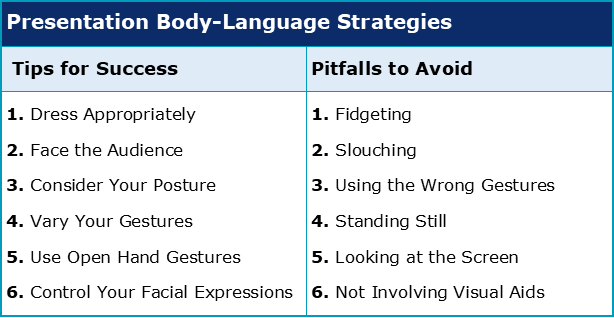Why is body language important in a presentation?

This is the first of three chapters about Body Language. To complete this reader, read each chapter carefully and then unlock and complete our materials to check your understanding.
– Discuss the key features of an academic presentation
– Introduce the concept of body language when presenting
– Outline twelve body-language strategies for students of English for Academic Purposes (EAP)
Before you begin reading...
-
video and audio texts
-
knowledge checks and quizzes
-
skills practices, tasks and assignments
Chapter 1
If you’re a student that’s studying at university in English then it’s quite likely that you’ll have to prepare an academic presentation to complete your bachelor’s or master’s degree. Even outside of academic contexts such as in job interviews or business meetings, the aspects of delivering a successful presentation are quite similar. Regardless of a presenter’s motivation for presenting, anyone that wishes to create an effective performance will want to focus on and improve aspects of their delivery, language accuracy and audience engagement.

This short three-chapter reader on body language focuses specifically on the features of facial expression, posture, position and movement that should, when used correctly, lead to a more successful academic presentation. This chapter first discusses the key features of presentations and body language, exploring the significance of these aspects when presenting in any context. Chapters 2 and 3 then introduce, explore and exemplify the twelve most important tips and pitfalls that students should follow and avoid if they wish to receive the highest grades in their assessments.
What are the key features of a presentation?
Students may not at first realise that there are many aspects that must be considered for a presentation to be successful. In truth, few people are naturally skilled at presenting (especially not the first time), and so practice and energy must be spent in evaluating personal weaknesses and in improving upon those weaknesses wherever necessary. While the topics of body language, delivery, presentation language and the use of visual aids all have their own more detailed short readers, we’ve nevertheless summarised these four aspects for your reference below:

What is body language?
Body language – also known as kinesics – is a type of non-verbal language in which a speaker uses their body to communicate with a listener or wider audience. A speaker may either (1) use their body to communicate as fully as in any other language, such as in sign language, (2) use only their body and not their voice to communicate simple concepts, as in mime, or (3) use their body to assist, deepen or emphasise their verbal communication – which is what we term the ‘body language’ of a presentation. Focussing on number three, there are five key types of body language that a new presenter should become familiar with, and these are:
- Gestures = such as using open hands or pointing towards a PowerPoint slide
- Eye Contact = how the presenter uses their eyes to incorporate the audience
- Postures = whether standing straight, spreading the legs, leaning or slouching
- Positioning = how the presenter moves about their performance space
- Facial Expressions = such as a smile, a raised eyebrow or a furrowed brow
It’s worth mentioning at this stage, however, that body language is somewhat cultural. A simple hand gesture or facial expression, for example, may mean one thing in one language and something entirely different in another. On Academic Marker, we will of course be referring to the interpretation of body language that’s most commonly used by English speakers around the globe.
Why is body language important?
While every feature of a presentation is likely to be just as important as the next, body language certainly assists in how confident, natural and engaging a speaker is. As a form of non-verbal input, body language can be used to guide the audience towards the correct opinion or the next part of the presentation. Such language can in fact be used to reinforce the speaker’s opinion or attach emphasis to a phrase, adding a layer of depth to the communication that words alone cannot muster. Ultimately, if you’re trying to get the best grade possible for an assessed academic presentation, or wish to impress your audience to the highest degree, then the careful application of correct body language will most certainly help.
What are the key body-language strategies?
As will be explored in much more detail in Chapters 2 and 3, there are twelve common strategies that students should pay attention to if they wish to have effective body language during their presentation. We’ve separated these twelve categories into six ‘tips for success’ and six ‘pitfalls to avoid’:

To learn more about these strategies, continue studying with Academic Marker.
Downloadables
Once you’ve completed all three chapters about body language, you might also wish to download our beginner, intermediate and advanced worksheets to test your progress or print for your students. These professional PDF worksheets can be easily accessed for only a few Academic Marks.
Collect Academic Marks
-
100 Marks for joining
-
25 Marks for daily e-learning
-
100-200 for feedback/testimonials
-
100-500 for referring your colleages/friends